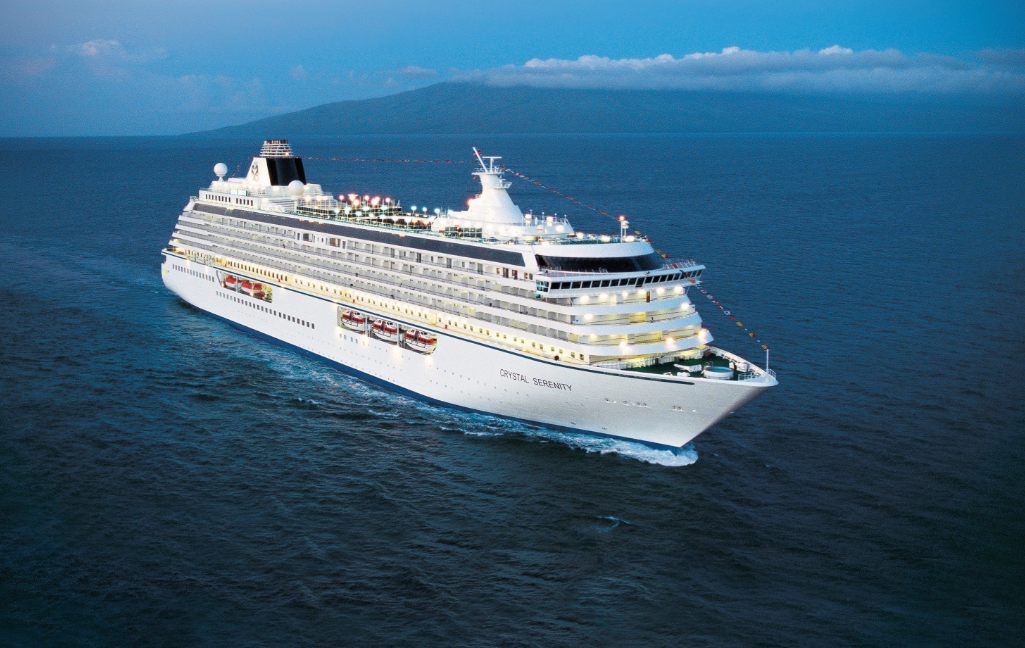Alaska communities prepare for Northwest Passage cruise ship

This summer, an extravagant cruise ship voyage will make history, and it’s starting in Alaska.
A luxury vessel, the $350 million Crystal Serenity can carry up to 1,070 passengers and 655 crew members, and measures 820 feet long. On board, you’ll find a casino, a library, penthouses and shops with name brands like Gucci, Armani and Dior, among other countless amenities.
On Aug. 16, the ship, full of creature comforts, will set out to travel through one of the world’s harshest sea routes — the icy and isolated waters of the Northwest Passage through the Arctic Ocean. It will wind through narrow waters in far northern Canada as it sails for the first time from Seward to New York City — a 32-day voyage geared toward affluent world travelers.
All you need is about $22,000 to be a passenger. That’s on the cheaper end of the scale — it’s as much as $120,095 for the fanciest penthouse (but not to worry: even the lower-level penthouses come with personal butlers). Even if you can afford the trip, too bad — the cruise has been booked since shortly after tickets went on sale in 2014.
Such a voyage comes with specific challenges should something go wrong. Alaska is bracing for how it might handle the worst-case scenarios that might be unique to the unprecedented journey, which California-based Crystal Cruises says is the largest cruise ship ever to take this route.
Future of transportation
Some communities in Alaska have been getting ready.
In Nome, Mayor Richard Beneville said the town has been planning for months to prepare itself for the largest infusion of tourists it has ever seen at once from a cruise.
“Without a doubt, Crystal Cruises’ Serenity is the largest one and is kind of a game changer,” Beneville said. “It’s indicating what’s going to be the future of transportation through the Bering Strait because of climate change.”
Beneville said that Nome is working closely with the Coast Guard to prepare for what to do in the case of an emergency with massive ships like the Crystal Serenity. But an upcoming training exercise there won’t happen until the day after the ship departs from Nome in August, which may seem counterintuitive.
“What they’re really concerned about is those areas north of Nome,” Beneville said.
Safety preparations
Derek Martin, the city manager in Kotzebue, told Alaska Dispatch News last year that an emergency response to accommodate 1,700 people would “create a bit of chaos” in the town of about 3,200. The ship won’t be stopping there, or in Barrow, but those areas would be affected if passengers had to unexpectedly disembark and head to the nearest community.
The Coast Guard, over the past few years, has carried out rescue operation exercises and workshops or developed emergency plans for cities like Kotzebue, Nome, Barrow and others, for what to do in the face of things like a man-made incident or natural disaster. This preparation is part of what’s called Operation Arctic Shield, the Coast Guard’s seasonal deployment to the Arctic.
Coast Guard Lt. Cmdr. Jason Boyle said that while the agency doesn’t do any rescue drills just for one specific company or industry, the Coast Guard has used the Crystal Serenity as the basis for some rescue operation exercises.
“What we would do from an agency perspective, how you would evacuate people if there was an accident on a ship if it was somewhere in the Arctic,” he said. “We’ve walked through with the communities about what the challenges are if you were to have a number of people show up in your community, where do you shelter the people? How do you deal with medical injuries?”
As sea ice in the region continues to recede, more Coast Guard attention and resources will probably go to such exercises, said Cmdr. Mark Wilcox, Arctic operational coordinator for the agency.
Cruise industry eyes North
Logistics and communication are the biggest hurdles when it comes to being prepared for the worst on routes like the one the Crystal Serenity will take, Wilcox said.
“Adapting to these constraints is the biggest challenge,” he said. “Communication is difficult in the Arctic; it’s more remote, the weather conditions are more extreme.”
Passengers on board the Crystal Serenity need to be prepared, too. They are required to get $50,000 in emergency evacuation insurance to cruise through the Northwest Passage. The ship will also be traveling with its own escort vessel, the RRS Ernest Shackleton, which has ice-breaking capabilities. That vessel will be complete with helicopters on board for safety purposes, and will join the cruise ship at the Canadian community of Uluhaktok.
Crystal Cruises isn’t the only company navigating the Northwest Passage. German company Hapag-Lloyd Cruises also has a Northwest Passage cruise that will depart in August and traverse Arctic waters around Canada and Greenland. Cargo ships have also made this voyage. Still, the Crystal Serenity appears poised to be the largest cruise ship to ever travel the route.
The company is wasting no time planning for next year — it has already announced another Northwest Passage voyage for summer 2017, and tickets are on sale.
Environmental questions
Lower levels of sea ice in the Arctic have opened this route up to vessels. Last month broughtanother record low for Arctic sea ice, according to the National Snow and Ice Data Center.
As far as environmental concerns for traveling through such a sensitive area, Crystal Cruises spokesman Paul Garcia said that both the cruise ship and the icebreaker will travel using low-sulfur fuels. He also said the company will discharge gray and black water — that’s wastewater from things like showers, washing machines and toilets — no less than 12 nautical miles from shore.
As for planning for the worst, Nome Mayor Beneville proceeds with caution.
“No one is expecting anything to happen,” he said, “but that’s what they said about the Titanic, too. We have learned over the years to try to be prudent.”
Related stories from around the North:
Canada: Arctic cruises are risky business says expert, Radio Canada International
Finland: Most luxury cruise liners still dumping sewage in Baltic Sea, Yle News
Iceland: Calls for action at Arctic shipping conference, Alaska Dispatch News
Norway: Arctic shipping: The myths, the realities & the challenges ahead, Eye on the Arctic
Russia: Arctic cruise industry expands, Cryopolitics Blog
Sweden: Swedish icebreakers gear up for Arctic role, Radio Sweden
United States: Arctic no shipping rival to Suez: expert, Alaska Public Radio Network



